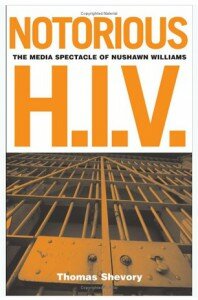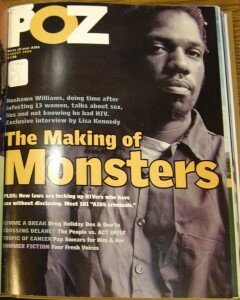June 28, 2013 (MAYVILLE, NY) – After nearly two weeks of highly technical testimony from medical and scientific experts, a Chautauqua County jury took one hour to decide that Nushawn Williams suffers from a mental abnormality that makes him subject to “civil management” and will either be confined to a secure treatment facility or kept under strict supervision.
One month before Nushawn Williams’ civil commitment trial, an examination of his blood shows no presence of the HIV virus, casting doubt on his 1999 reckless endangerment, HIV-transmission conviction. Williams’ attorney, John Nuchereno, had a court-ordered blood draw sent to the University of Massachusetts Medical School. Using an electron microscope, a scientist found no evidence of HIV.
Spring 1996: Several young women test positive for HIV in Jamestown, New York. At the time, the women said they shared a common sexual partner–Nushawn Williams, 18, a drifter and low-level drug dealer. County Health Officials approached Nushawn, who voluntarily consented to be tested for the HIV virus. The results were released not to Nushawn, but to Dr. Robert Berke of the Chautauqua County Department of Health, who assumed that Nushawn was infected with HIV. While scores of clinicians also assumed that Nushawn was infected with the virus, nothing in the medical record indicates that Dr. Berke or any other physician made any attempt to clinically confirm the presence of the alleged infection, an FDA requirement.
October 1997: A 13-year old girl acknowledges having sex with Williams on two occasions.
November 1997: A New York State Supreme Court Judge authorizes the Commissioner of Chautauqua County Department of Health to release to the public Nushawn’s identity and HIV information – although it was confidential. The next day, Williams is arrested and charged in Jamestown with two counts of statutory rape (consensual sex with a minor). As with most lawyers at the time, the public defender assigned to the case knew little about the testing, diagnosis and treatment of HIV, and limited understanding of the criminal transmission of HIV.  December 1997: Media and public hysteria results in false and exaggerated information about Williams, tagged “Notorious HIV” by the press. Williams pleads guilty to two counts of second-degree (statutory) rape and one count of reckless endangerment. At the time, authorities claimed he had infected at least 13 young Chautauqua County women, including a 13-year-old girl, with HIV.
December 1997: Media and public hysteria results in false and exaggerated information about Williams, tagged “Notorious HIV” by the press. Williams pleads guilty to two counts of second-degree (statutory) rape and one count of reckless endangerment. At the time, authorities claimed he had infected at least 13 young Chautauqua County women, including a 13-year-old girl, with HIV.
June 1998: NY State Legislature passes major revision to the state’s public health law. Physicians and labs are now required to notify public health officials whenever a person tests positive for HIV. It also authorizes local health officials to notify those individuals who might be at risk of contract HIV from those who have tested positive.
February 26, 1999: Williams pleads guilty to Reckless Endangerment in the 1st Degree, acknowledging that he recklessly engaged in unprotected sexual relations with a female knowing he was infected with HIV and but failed to inform his sexual partner.
April 5, 1999: Williams is sentenced in Chautauqua County to serve four to 12 years in prison. His attorneys did not file an appeal.
April 2010: Due for release after serving his maximum 12-year sentence, Williams, 34, is kept in custody under the state law that permits the civil confinement of sex offenders.
Fall 2010: OMSJ begins to examine the medical records and HIV test results from the case. OMSJ investigators discover that health officials and clinicians appeared to have made no attempt to diagnose Williams, as mandated by FDA test package inserts and manufacturers. Additionally, OMSJ’s examination of the testing technologies and use of electron microscopy (EM) since 2012 demonstrated that “positive” or “reactive” results in standard ELISA and Western Blot tests are medically and scientifically unreliable.
Spring 2011: Medical and scientific experts find no evidence in the medical record that Nushawn Williams is, or ever was,, infected with HIV.
May 2013: Williams’ defense team obtains court order to send his blood sample to the University of Massachusetts CORE Microscopy Laboratory for analysis. No evidence of HIV is found. HIV discoverers Luc Montagnier and Robert Gallo have used electron microscopy to identify and examine HIV since 1983.
 May 18, 2013: (Seymour Johnson AFB, NC) In an unrelated military HIV case, USAF Capt. Mark Rosenow contacts a University of Massachusetts (U. Mass) board chair to allege that its CORE microscopy laboratory where Williams’ blood sample was examined was being misused. Capt. Rosenow’s allegations result in an investigation that threatens the credibility, reputation and career of OMSJ’s EM expert. Fearing for his professional future, Gregory Hendricks PhD withdraws from the USAF case and all other OMSJ cases – including the defense of Nushawn Williams.
May 18, 2013: (Seymour Johnson AFB, NC) In an unrelated military HIV case, USAF Capt. Mark Rosenow contacts a University of Massachusetts (U. Mass) board chair to allege that its CORE microscopy laboratory where Williams’ blood sample was examined was being misused. Capt. Rosenow’s allegations result in an investigation that threatens the credibility, reputation and career of OMSJ’s EM expert. Fearing for his professional future, Gregory Hendricks PhD withdraws from the USAF case and all other OMSJ cases – including the defense of Nushawn Williams.
May 21, 2013: A motions hearing is held at Seymour Johnson AFB to determine if Capt. Rosenow’s conduct dissuaded a witness from testifying. A ruling is expected this week. May 23, 2013: AP quotes pharma-connected doctors who question the use of electron microscopy.
June 3, 2013: Prosecutor’s actions dissuade witness – may jeopardize Nushawn Williams defense.
June 12, 2013: Jury selection is set to begin in the trial to challenge Williams’ civil commitment. Media coverage:
- Harpers, Wypijewski, JoAnn (July 1998), “Sex, Race and Denial in an American Small Town”
- The Nation, Wypijewski, JoAnn (June 2010), “What We’ve Become”
- WGRZ, May 22
- BUFFALO NEWS, May 21, May 22, June 8, June 13
- WBLK FM, May 22
- OBSERVER, May 23
- Associated Press May 23
- WIVB, May 23
- Daily Journal – Jury finds Williams suffers from a “mental abnormality” and should remain confined (28 May 2013).
- HPAY interviews Thomas Shevory, author of Notorious HIV: The Media Spectacle of Nushawn Williams (2004) (AUDIO)
More from my site
Tags: Chautauqua, Jamestown, John Nuchereno, Mark Rosenow, New York, Nushawn Williams, prosecutorial misconduct, Robert Berke MD, USAF











